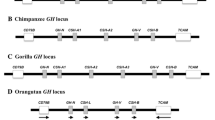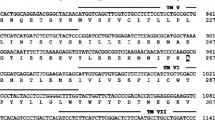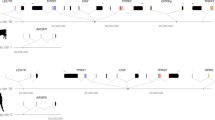Abstract
The prolactin gene family in rodents consists of multiple members that coordinate the processes of reproduction and pregnancy. Some members of this family acquired one or two additional exons between exon 2 and exon 3 of the prototypical 5-exon, 4-intron structure, but the evolutionary importance of this insertion is unclear. Here, we focus on those members and survey this question by molecular evolutionary methods. Phylogenetic analysis shows that those members cluster into two distinct groups. Further analysis shows that the two groups of genes originated before the divergence of mouse and rat but after that of rodents from other mammals. We compared the d N/d S values for each branch of the gene tree but found no evidence to support positive selection for any branch. We found strong evidence, however, that one site (11E) of the 13 sites of the first extra exon underwent positive selection by the site-specific models of the maximum-likelihood method. Combining our molecular evolutionary analysis with other known functional evidence, we believe that the insertion of the extra exon implies some functional adaptation.




Similar content being viewed by others
REFERENCES
Bhattacharyya, S., Lin, J., and Linzer, D. I. H. (2002). Reactivation of a hematopoietic endocrine program of pregnancy contributes to recovery from thrombocytopenia. Mol. Endocrinol. 16:1386–1393.
Bittorf, T., Jaster, R., Soares, M. J., Seiler, J., Brock, J., Friese, K., and Muller, H. (2000). Induction of erythroid proliferation and differentiation by a trophoblast-specific cytokine involves activation of the JAK/STAT pathway. J. Mol. Endocrinol. 25:253–262.
Chien, Y. H., and Thompson, E. B. (1980). Genomic organization of the rat prolactin and growth hormone genes. Proc. Nat. Acad. Sci. 77:4583–4587.
Conliffe, P. R., Farmerie, W. G., Charles, G. D., Buhi, W. C., Kelly, P. A., Simmen, R. C. M., and Shiverick, K. T. (1994). Expression and characterization of recombinant rat placental prolactin-like protein C. Mol. Cell. Endocrinol. 106:121–130.
Connor, A. M., Waterhouse, P., Khokha, R., and Denhardt, D. T. (1989). Characterization of a mouse mitogen-regulated protein/proliferin gene and its promoter: A member of the growth hormone/prolactin gene superfamily. Biochimica. Biophysica. Acta 1009:75–82.
Cooke, N. E., and Baxter, J. D. (1982). Structural analysis of the prolactin gene suggests a separate origin for its 5, end. Nature 297:603–606.
Cooke, N. E., Szpirer, C., and Levan, G. (1986). The related genes encoding growth hormone and prolactin have been dispersed to chromosomes 10 and 17 in rat. Endocrinology 119:2451–2454.
Dai, G., Liu, B., Szpirer, C., Levan, G., Kwok, S. C. M., and Soares, M. J. (1996). Prolactin-like protein-C variant: Complementary deoxyribonucleic acid, unique six exon gene structure, and trophoblast cell-specific expression. Endocrinology 137:5009–5019.
Dai, G., Chapman, B. M., Wang, D., White, R. A., Preuett, B., and Soares, M. J. (1999). Prolactin-like protein A gene structure and chromosomal mapping. Mamm. Genome. 10:78–80.
Forsyth, I. A., and Wallis, M. (2002). Growth hormone and prolactin: Molecular and functional evolution. J. Mammary Gland Biol. Neoplasia 7(3):291–312.
Glazko, G. V., Koonin, E. V., and Rogozin, I. B. (2005). Molecular dating: Ape bones agree with chicken entrails. Trends Genet. 21:89–92.
Grus, W. E., and Zhang, J. Z. (2004). Rapid turnover and species-specificity of vomeronasal pheromone receptor genes in mice and rats. Gene 340:303–312.
Hwang, I. T., Lee, Y. H., Moon, B. C., Ahn, K., Lee, S. W., and Chun, J. Y. (2000). Identification and characterization of a new member of the placental prolactin-like protein-C (PLP-C) subfamily, PLP-Cβ. Endocrinology 141(9):3343–3352.
Jackson, D., Volpert, O. V., Bouck, N., and Linzer, D. I. H. (1994). Stimulation and inhibition of angiogenesis by placental proliferin and proliferin-related protein. Science 266:1581–1584.
Jackson-Grusby, L. I., Pravtcheva, D., Ruddle, F. H., and Linzer, D. I. H. (1988). Chromosomal mapping of the prolactin/growth hormone gene family in the mouse. Endocrinology 122:2464–2466.
Jacobs, L. L., and Pilbeam, D. (1980). Of mice and men: Fossil-based divergence dates and molecular “clocks.” J. Hum. Evol. 9:551–555.
Jeanmougin, F., Thompson, J. D., Gouy, M., Higgins, D. G., and Gibson, T. J. (1998). Multiple sequence alignment with Clustal X. Trends Biochem. Sci. 23:403–405.
Kumar, S., and Hedges, S. B. (1998). A molecular timescale for vertebrate evolution. Nature 392:917–920.
Kumar, S., Tamura, K., Jakobsen, I. B., and Nei, M. (2001). MEGA2: Molecular evolutionary genetics analysis software. Bioinformatics 17:1244–1245.
Li, P., and Bousquet, J. (1992). Relative-rate test for nucleotide substitutions between two lineages. Mol. Biol. Evol. 9:1185–1189.
Li, Y., and Zhang, Y. P. (2006). Molecular evolution of prolactin gene family in rodents. Acta Genet. Sinica 33(7):590–597.
Lin, J., and Linzer, D. I. H. (1999). Induction of megakaryocyte differentiation by a novel pregnancy-specific hormone. J. Biol. Chem. 274:21485–21489.
Nei, M., Xu, P., and Glazko, G. (2001). Estimation of divergence times from multiprotein sequences for a few mammalian species and several distantly related organisms. Proc. Nat. Acad. Sci. 98:2497–2502.
O’Huigin, C., and W.-H. Li (1992). The molecular clock ticks regularly in muroid rodents and hamsters. J. Mol. Evol. 35:377–384.
Rasmussen, C. A., Hashizume, K., Orwig, K. E., Xu, L., and Soares, M. J. (1996). Decidual prolactin-related protein: Heterologous expression and characterization. Endocrinology 137:5558–5566.
Rat Genome Sequencing Consortium (2004). Genome sequence of the brown Norway rat yields insights into mammalian evolution. Nature 428:493–521.
Rechavi, M. R., and Huchon, D. (2000). RRTree: Relative-rate tests between groups of sequences on a phylogenetic tree. Bioinformatics 16(3):296–297.
Robinson, M., Catzeflis, F., Briolay, J., and Mouchiroud, D. (1997). Molecular phylogeny of rodents, with special emphasis om murids: Evidence from nuclear gene LCAT. Mol. Phy. Evol. 8:423–434.
Saitou, N., and Nei, M. (1987). The neighbor-joining method: A new method for reconstructing phylogenetic trees. Mol. Bio. Evol. 4:406–425.
Shida, M. M., Jackson-Grusby, L. L., Ross, S. R., and Linzer, D. I. H. (1992). Placental-specific expression from the mouse placental lactogen II gene promoter. Proc. Nat. Acad. Sci. 89:3864–3868.
Soares, M. J., Chapman, B. M., Rasmussen, C. A., Dai, G., Kamei, T., and Orwig, K. E. (1996). Differentiation of trophoblast endocrine cells. Placenta 17:277–289.
Soares, M. J., Miiller, H., Orwig, K. E., Peters, T. J., and Dai, G. (1998). The uteroplacental prolactin family and pregnancy. Biol. Reprod. 58:273–284.
Wiemers, D. O., Shao, L. J., Ain, R., Dai, G., and Soares, M. J. (2003). The mouse prolactin gene family locus. Endocrinology 144(1):313–325.
Wong, W. S. W., Yang, Z., Goldman, N., and Nielsen, R. (2004). Accuracy and power of statistical methods for detecting adaptive evolution in protein coding sequences and for identifying positively selected sites. Genetics 168:1041–1051.
Yang, Z. (1997). PAML: A program package for phylogenetic analysis by maximum likelihood. Comput. Appl. Biosci. 13:555–556 (http://abacus.gene.ucl.ac.uk/software/paml.html).
Yang, Z., Nielsen, R., Goldman, N., and Pedersen, A.-M. K. (2000). Codon-substitution models for heterogeneous selection pressure at amino acid sites. Genetics 155:431–449.
Yang, Z., Wong, W. S. W., and Nielsen, R. (2005). Bayes empirical Bayes inference of amino acid sites under positive selection. Mol. Biol. Evol. 22:1107–1118.
Zhang, J. (2003). Evolution by gene duplication: An update. Trend. Ecol. Evol. 18(6):292–298.
Zhang, J., Rosenberg, H. F., and Nei, M. (1998). Positive Darwinian selection after gene duplication in primate ribonuclease genes. Proc. Nat. Acad. Sci. 95:3708–3713.
ACKNOWLEDGMENTS
This work was supported by the National Natural Science Foundation of China (30021004, 30430110). Yang Li was supported by Light in Western China of the Chinese Academy of Sciences. We thank Mr. Nelson Ting from the City University of New York for his great effort in editing this paper.
Author information
Authors and Affiliations
Corresponding author
Rights and permissions
About this article
Cite this article
Li, Y., Huang, JF. & Zhang, YP. Adaptive Evolution of the First Extra Exon in the Murid Rodent Prolactin Gene Family. Biochem Genet 45, 397–408 (2007). https://doi.org/10.1007/s10528-007-9081-2
Received:
Accepted:
Published:
Issue Date:
DOI: https://doi.org/10.1007/s10528-007-9081-2




